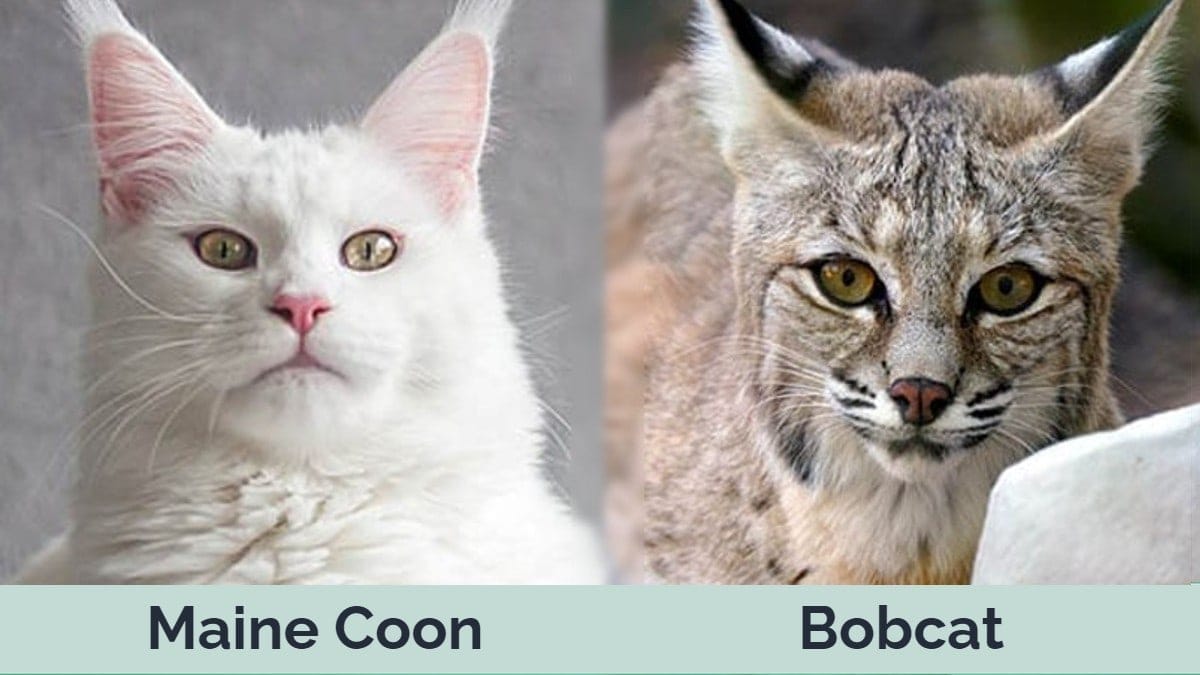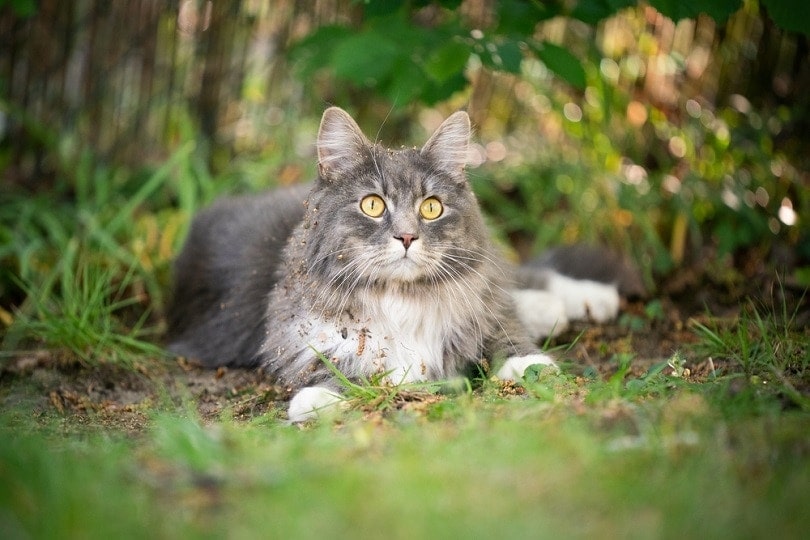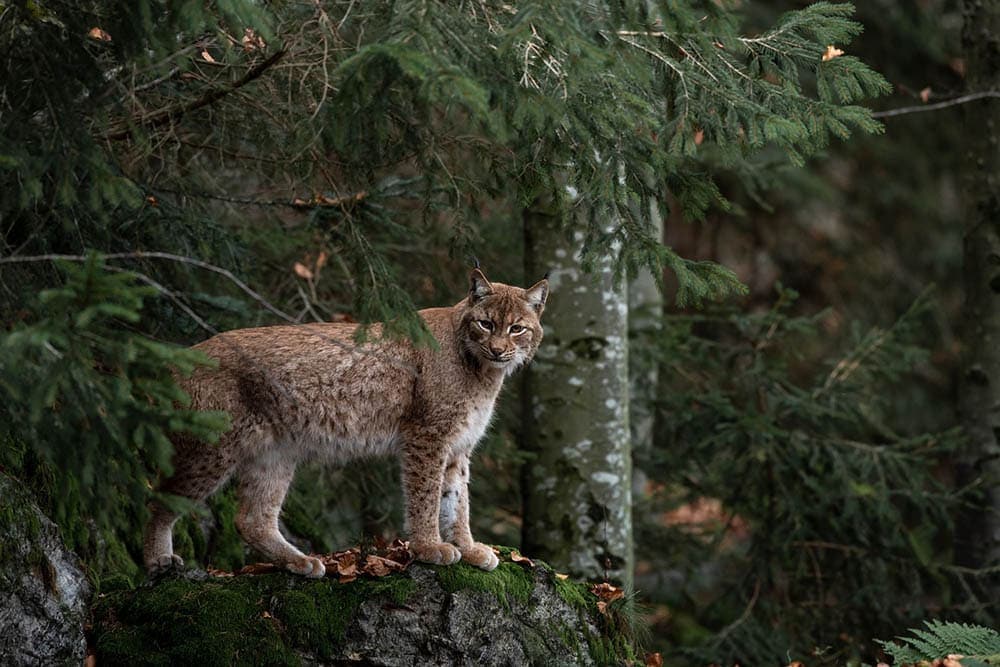Maine Coon vs Bobcat: How Are They Different? (with Pictures)
Updated on

Click to Skip Ahead
If you’re curious about how Maine Coons and bobcats are alike and how they are different, this article will provide some answers for you. Keep reading to learn facts about both animals that will help you tell the difference between them.
Visual Differences

At a Glance
- Origin: United States
- Size: 8-16 inches tall, 37-40 inches long, 10-25 pounds
- Lifespan: 12-15 years
- Domesticated?: Yes
- Origin: North America
- Size: 20-24 inches tall, 24-40 inches long, 15-33 pounds
- Lifespan: 5-15 years
- Domesticated?: No
Maine Coon Overview

Characteristics & Appearance
Maine Coons are large cats with thick, luxurious coats that come in about 75 different color and pattern combinations. They are known for their long bodies and tails. In fact, the world record for the longest cat is held by a Maine Coon from Italy.
The Maine Coon’s paws are wide and fluffy, allowing them to walk on top of the snow during cold Maine winters. Their signature tufts on their ears were also a practical development, meant to keep ears warm and protected from the chill.
The Maine Coon cats are known for their friendly, affectionate, dog-like personalities. Despite their size, they are gentle and calm with children and other pets. They are one of the more trainable cat breeds.
These cats’ desire to be around their humans is so strong that it borders on obsessiveness. Privacy and personal space may be a thing of the past if you own a Maine Coon! Unlike most cats, Maine Coons usually don’t mind water and may even enjoy playing in it.
Human Interactions
In the past, Maine Coons served as barn cats and pest control specialists, keeping pesky rodents out of their humans’ homes and crops. Today, they are among the most popular pet cat breeds, especially for families.
Because of their trainable, friendly personalities, Maine Coons are often used as therapy cats. Maine Coons are also famous show cats. A Maine Coon cat won the first-ever major cat show held in America, in 1895.
Bobcat Overview

Characteristics & Appearance
Bobcats are solitary, North American wild cats that live throughout the United States and range as far as Mexico and southern Canada. They live in a variety of habitats and climates including forests, swamps, and deserts. Bobcats are related to three other similar species: Canadian lynx, Iberian lynx, and Eurasian lynx, who are larger and live exclusively in cold, northern climates.
The bobcat’s coat is brown or reddish-brown with darker spots and stripes. They are lighter on their bellies and chests. Bobcats have tufted ears with a white mark on the back of each one. Their tails are short and stubby, and they have fluffy faces.
Swift runners and expert climbers, bobcats hunt mainly rabbits. They also stalk other small rodents, deer, and domestic animals. Active primarily at dusk and dawn, bobcats may travel as far as 2-7 miles a day while hunting. Bobcats are shy, secretive animals, only rarely observed by humans.
Bobcats live alone except during mating season. They are territorial and mark their established range with scent and visual signs. A female bobcat gives birth to 2-4 cubs per year who live with her until they are about 3-5 months old before striking out on their own.
Human Interactions
Bobcats are hunted and trapped by humans for their pelts. In the mid-19th century, bobcats were overhunted until they nearly became extinct. Fortunately, conservation and reintroduction programs have helped the species rebound, and they are now a species of least concern.
Because bobcats need such large ranges, they are often in competition for space with expanding human development. They may become nuisances if they start preying on farm animals or pets. Bobcats can also spread disease to domestic cats.
As a top-tier predator, bobcats play a vital role in maintaining healthy ecosystems, which also benefit the humans who live there.
Without bobcats, the populations of prey animals like rabbits and deer would grow out of control. All those herbivores take a toll on the plant life in the environment and can lead to issues with erosion and water quality.
What Are the Differences Between Maine Coons and Bobcats?
The primary difference between Maine Coons and bobcats is that one is a pampered, domesticated house pet and the other is a secretive, wild animal that should not be kept as a pet. Bobcats are rarely seen by humans, while Maine Coons are rarely seen apart from theirs!
Another difference between the two animals is their appearance, despite the rumors of bobcats contributing to the breed development of Maine Coons.
Bobcats are taller, heavier, and have shorter tails than Maine Coons. Both animals have tufted ears and thick coats, although the Maine Coon comes in many more colors and patterns than the bobcat. Maine Coons generally tend to be longer than bobcats, who are short-bodied relative to their size.
Though they originate in the United States, Maine Coon cats can now be found worldwide. Bobcats live only in North America.
Conclusion
Both bobcats and Maine Coons are fascinating members of the cat family in their own right. However, beyond that, they don’t have a whole lot in common besides maybe their ear tufts. Despite this, Maine Coons continue to find themselves mistaken for their wild relatives, often with unfortunate results. Now that you’ve learned the differences between bobcats and Maine Coons, you won’t be the one making those mistakes!
See also:
- Are There Wild Cats in Michigan? Popular Breeds (With Pictures)
- Do Cats Have Control Over Their Tails? Feline Anatomy Facts & FAQs
Featured Image Credit:Left: Maine Coon (Nils Jacobi, Shutterstock), Right: Bobcat (milesz, Pixabay)












